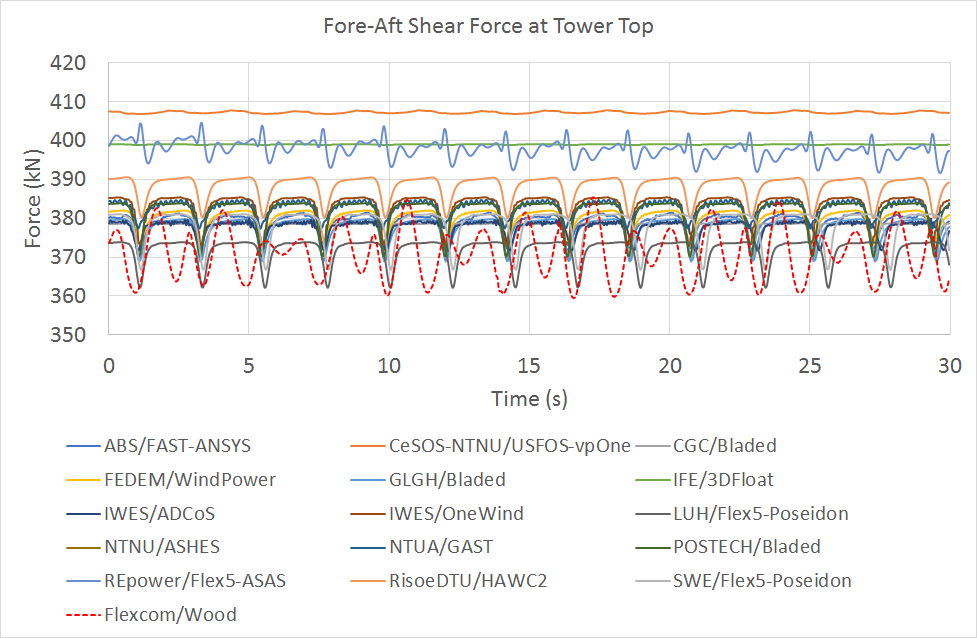Good agreement is shown between all software tools for the mean generator power and rotor speed. The tower blockage effect is captured by most tools, including Flexcom, as small fluctuations of the generator power and rotor speed. The generator power predicted by Flexcom is slightly lower than most of the other software tools (apart from ADCoS which had an acknowledged miscalculation of the flow stagnation effect in front of the tower during OC4). Flexcom's mean power is 1727.6 kW, just 2.5% below the average (1780.1 kW). It is worth noting that there is a 6.2% variation across the other software tools also. Differences in mean rotor speed is less than 2.7%. Flexcom's results are very close to the median of OC4 data.
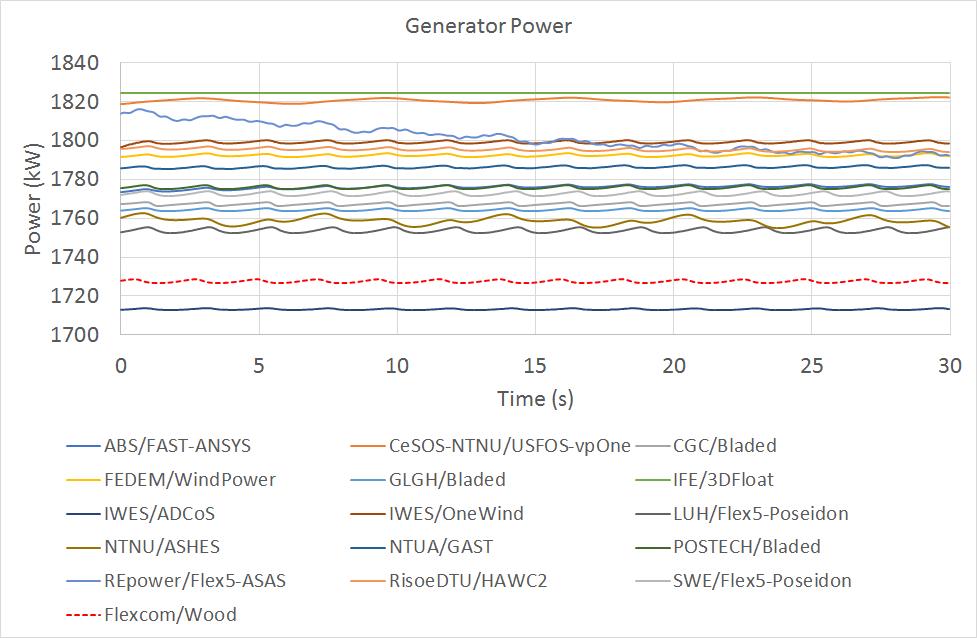
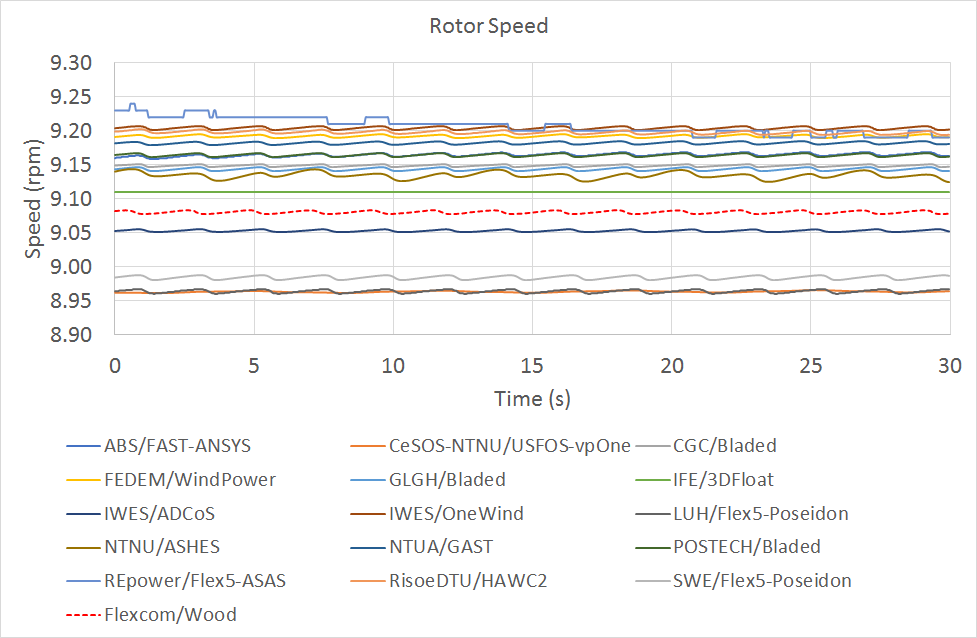
Given that generator power is such a fundamental output for a wind turbine, this issue merits further discussion. Discrepancies in power may be caused by several factors, including...
1.Variations in the aerodynamic theories underpinning each software product
2.Inconsistencies in user selection of aerodynamic modelling options within the software
3.Participants using different versions of the same software product
4.Slight discrepancies in computed structural deformations which influence aerodynamic performance
To better understand the discrepancies, this load case was also examined with NREL’s FAST software. An official release of FAST was downloaded, Version 8.16, which appeared to be the latest version available at the time of writing. Although the sample input files provided by NREL corresponded to OC4 P1 LC5.7 (these were the only input files published by NREL), it was a simple task to recreate the input files required for OC4 P1 LC2.2, by removing the wave loading, and making the jacket and tower rigid by disabling their respective degrees of freedom. Key output parameters, such as mean generator power and rotor speed, predicted by FAST V8.16 were found to be lower than those presented in Popko et al. (2012) for ABS who used a combination of FAST and the structural modelling software ANSYS. When discrepancies in results were queried with NREL via their online user forum, NREL advised that “the CertTest model (i.e. the more recent version) uses AeroDyn15 with BEMT (i.e. blade element momentum theory), while the original OC4 simulation used AeroDyn14 with DYNIN (i.e. dynamic inflow)”, and consequently that “due to these different modelling approaches it is expected to observe some differences in predicted system response between the two models”. Although the query and response relate to the semi-submersible platform of OC4 Phase II (see OC4 P2 LC3.1 Deterministic, below rated for a similar discussion), differences in aerodynamic results are relevant to the jacket structure also.
Flexcom’s mean generator power is 2.7% lower than the original ABS results. However, when the simulation is run with FAST V8.16, Flexcom's mean power agrees to within 0.7%, and this discrepancy reduces even further to 0.5% when rigid blades are used in the FAST model. Hence it is concluded that much of the difference between Flexcom and the official OC4 results presented by ABS stem from different versions of the aerodynamic modelling software AeroDyn. The remaining discrepancy may be attributed to the simplified RNA model used in the Flexcom simulations. Furthermore, Flexcom’s mean rotor speed is closer to 9rpm, which is consistent with the official load case definition.
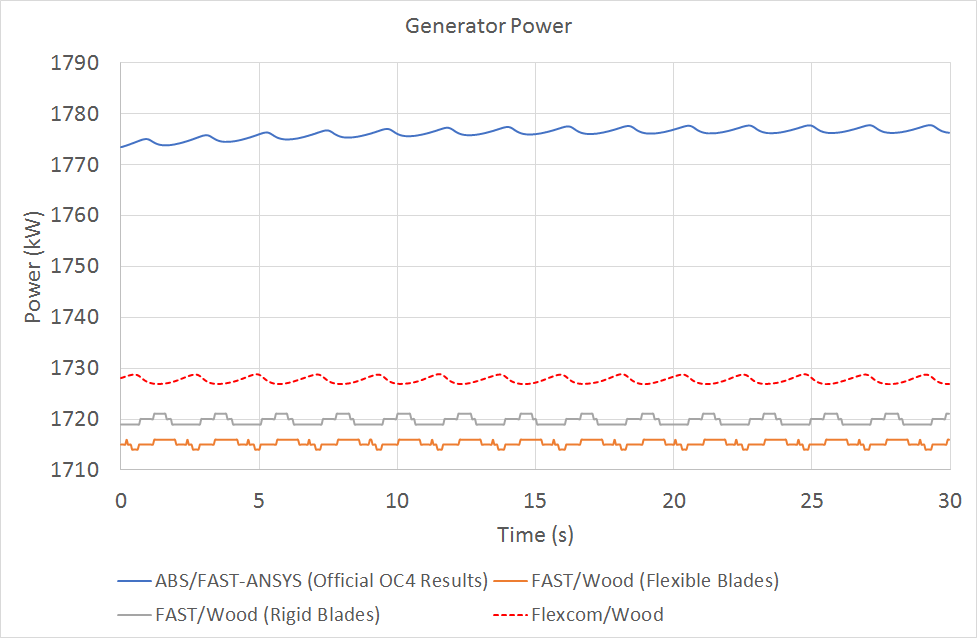
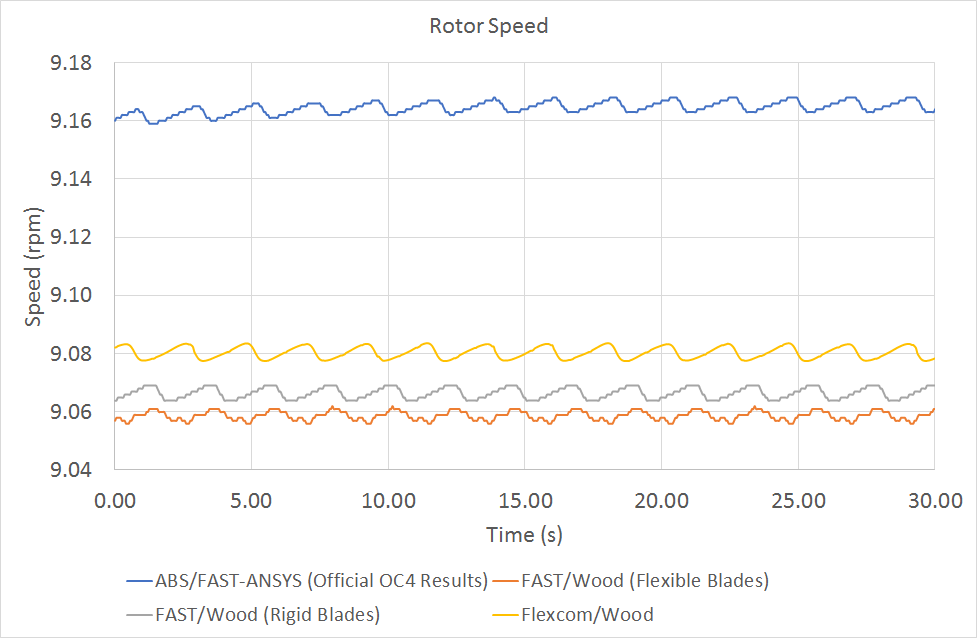
Similar to generator power, the generator torque shows close agreement between all tools. It is accurately predicted by Flexcom as this information comes directly from ServoDyn, the control and electrical drive dynamics module of FAST. The low speed shaft torque shows good agreement between many of the software tools, with most codes showing downward peaks corresponding to the blade passing (3P) frequency. These peaks are not demonstrated by the Flexcom signal, given that a simplified RNA model is used in Flexcom 8.12.1. Specifically, the shaft is not modelled explicitly, and is instead represented by a rigid element which connects the hub location to the top of the tower. This element is non-rotational and its sole purpose is to transfer the aerodynamics loads from the hub to the tower. As the low-speed shaft torque is unknown in the current Flexcom model, it is derived from the generator torque and the gearbox ratio, and this leads to a smoother signal than most of the other modelling tools. It is interesting to note that the low-speed shaft torque is calculated indirectly for the IWES/ADCoS results also, and these results show close agreement with Flexcom.

Like the shaft torque, the fore-aft shear force at the top of the tower shows good agreement between most of the modelling tools. The time history also shows the characteristic downward peaks corresponding to the 3P frequency. Although the mean force predicted by Flexcom is similar to the others, just 3.5% below the average, the variation over time is not accurately captured due to the lack of modelling detail for the RNA. The simplified RNA model in Flexcom 8.12 considers that blade deformations under applied loading are negligible, hence the blade geometries are approximated as rigid profiles. Consequently, blade rotational inertia effects are not included in the simulation, which accounts for the differences between the Flexcom solution and several of the other tools that employ more detailed modelling of the RNA. Work is presently under way to develop a more detailed RNA model that explicitly models the blades with finite elements, thereby allowing blade deformations and rotational inertia to be accurately captured.
